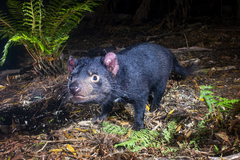Tasmanian devils are stocky with a brownish black pelage. They have a white throat patch, white spots on their sides and backside, and a pinkish snout. The head is massive with well developed jaw muscles. Molar teeth are heavy and adapted for their role in crushing bone and tearing through muscle and thick skin.
Mainly a scavenger with a very varied diet, they will eat almost anything they come across. Its powerful jaws allow it to consume its prey entirely - bones and fur. They can often be heard screaming and squabbling over carcasses.
Unfortunately the Devil Facial Tumour Disease (DFTD) has had a major impact on the species across the state and has seen a significant decline in numbers, Thanks to breeding programs and ongoing research numbers have started to improve.
Tasmanian devils are protected in Tasmania
Sorry I am working on providing identification images and information for this species please check back soon
What habitats does Sarcophilus harrisii live in?
They are most numerous in coastal heath and rangeland areas where agricultural practices maintain a constant supply of carrion. They also occur in open, dry schlerophyll forest and mixed schlerophyll rainforest. Their dens typically are located in hollow logs, caves, or burrows.
What is the distribution of Sarcophilus harrisii?
Endemic and widespread across Tasmania
How big does Sarcophilus harrisii grow?
Males weight ranges from 5.5 to 12 kg and female weight from 4.1 to 8.1 kg and range in length from 50cm to 80cm
Disclaimer: A lot of work goes into trying to identify and ensure accurate identifications are made and that the listed Descriptions, Sizes, Habitats and Distribution information is as accurate and valid as possible. Unfortunately, information in this arena is ever changing and as such no guarantee can be offered that it is correct or currently valid as a result the information is provided as a guide, and it is always suggested that you do a little research to ensure you have the latest and most accurate information. View the reference's or bibliography I welcome any feedback and comments on the information provided.
